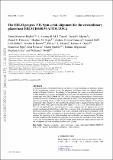The EBLM project. VII. Spin-orbit alignment for the circumbinary planet host EBLM J0608-59 A/TOI-1338 A
Abstract
A dozen short-period detached binaries are known to host transiting circumbinary planets. In all circumbinary systems so far, the planetary and binary orbits are aligned within a couple of degrees. However, the obliquity of the primary star, which is an important tracer of their formation, evolution, and tidal history, has only been measured in one circumbinary system until now. EBLM J0608-59/TOI-1338 is a low-mass eclipsing binary system with a recently discovered circumbinary planet identified by TESS. Here, we perform high-resolution spectroscopy during primary eclipse to measure the projected stellar obliquity of the primary component. The obliquity is low, and thus the primary star is aligned with the binary and planetary orbits with a projected spin-orbit angle β = 2.°8 ± 17.°1. The rotation period of18.1 ± 1.6 d implied by our measurement of vsinI⋆ suggests that the primary has not yet pseudo-synchronized with the binary orbit, but is consistent with gyrochronology and weak tidal interaction with the binary companion. Our result, combined with the known coplanarity of the binary and planet orbits, is suggestive of formation from a single disc. Finally, we considered whether the spectrum of the faint secondary star could affect our measurements. We show through simulations that the effect is negligible for our system, but can lead to strong biases in vsinI⋆ and β for higher flux ratios. We encourage future studies in eclipse spectroscopy test the assumption of a dark secondary for flux ratios ≳1ppt.
Citation
Hodžić , V K , Triaud , A H M J , Martin , D V , Fabrycky , D C , Cegla , H M , Cameron , A C , Gill , S , Hellier , C , Kostov , V B , Maxted , P F L , Orosz , J A , Pepe , F , Pollacco , D , Queloz , D , Ségransan , D , Welsh , W F & Udry , S 2020 , ' The EBLM project. VII. Spin-orbit alignment for the circumbinary planet host EBLM J0608-59 A/TOI-1338 A ' , Monthly Notices of the Royal Astronomical Society , vol. 497 , no. 2 , pp. 1627–1633 . https://doi.org/10.1093/mnras/staa2071
Publication
Monthly Notices of the Royal Astronomical Society
Status
Peer reviewed
ISSN
0035-8711Type
Journal article
Description
Funding: This work was inpart funded by the U.S.–Norway Fulbright Foundation and a NASATESSGI grant G022253 (PI: Martin). AHMJT received funding from the European Research Council (ERC) under the European Union’s Horizon 2020 research and innovation programme (grant 803193/BEBOP), and from a Leverhulme Trust Research Project grant (RPG-2018-418). VKH is also supported by a Birmingham Doctoral Scholarship, and by a studentship from Birmingham’s School of Physics & Astronomy. DVM received funding from the Swiss National Science Foundation (grant P 400P2 186735). SG has been supported by STFC through consolidated grants ST/L000733/1and ST/P000495/1.Collections
Items in the St Andrews Research Repository are protected by copyright, with all rights reserved, unless otherwise indicated.

